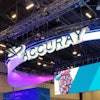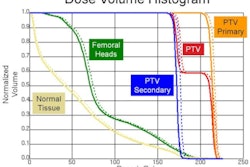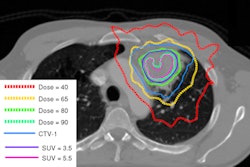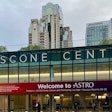With a note of appreciation to Albert Einstein, medical physicists at Boston's Brigham and Women's Hospital are learning how gold nanoparticles (AuNPs) can serve as an effective secondary source of cancer-killing electrons generated as a byproduct of the element's exposure to radiation.
Ross Berbeco, PhD, a physicist at the hospital, presented preliminary findings on the technology on August 3 at the 2011 American Association of Physicists in Medicine (AAPM) meeting in Vancouver.
Berbeco's most recent results combine with several published reports in the past nine months demonstrating the possible added therapeutic power of gold.
"Gold nanoparticles can play a synergistic role with radiation therapies, enhancing their efficiencies and reducing their risks," Berbeco said.
The photoelectric effect
Gold's added punch comes from the photoelectric effect, first described by physicist Heinrich Hertz in the 19th century. The effect can generate a one-two punch during cancer treatment that knocks out tumor vasculature harboring microscopic gold particles at the same time that brachytherapy or external-beam radiation directly attacks the primary tumor.
Hertz discovered that electrons are emitted from metal and other forms of matter by absorbing energy from short-wavelength electromagnetic radiation.
The implications of this finding for the use of gold in radiation therapy can be seen in mathematical calculations that earned Albert Einstein a Nobel Prize in 1921. He predicted that the energy of individually emitted electrons, now called photo/Auger electrons, increases linearly with the frequency of light, such as the powerful x-rays used in external-beam radiation therapy or the radiation emitted by decaying radioisotopes in brachytherapy.
By disrupting tumor vasculature, AuNPs can cut off tumor cells from their blood supply and source of nutrition, Berbeco said.
Numerous strategies have been posed to disrupt the angiogenic process and resulting microvasculature associated with tumor growth, but their success has been limited because of imperfect targeting, he noted. However, early research indicates that AuNPs naturally become entangled in highly permeable and torturous angiogenic vessels.
The findings presented in Vancouver suggest that enough gold accumulates to do severe biological damage to tumor endothelial cells, without affecting healthy tissues that do not contain the nanoparticles.
The first step of this research was a series of computer simulations described in several studies in the past year. These inquiries established a correlation between the concentration of AuNPs accumulated in the endothelial neovasculature and the increased efficacy of 50-kVp external-beam radiation therapy or brachytherapy with palladium-103, iodine-125, or ytterbium-160 isotopes (Physics in Medicine and Biology, November 7, 2010, Vol. 55:21, pp. 6533-6548).
"Although we have also shown that the concept may work for external-beam radiation therapy, brachytherapy is particularly attractive for this idea due to the way this low-energy type of radiation interacts with the gold," Berbeco said.
Another study predicted AuNPs could boost the endothelium dose enhancement factor for conventional linear accelerator x-rays at a 20-cm depth from 20% to 340%, while increasing the dose by 70%.
Berbeco's group is now entering the experimental phase of its investigation. Even without in vivo research, Berbeco is encouraged by gold's potential.
"Gold nanoparticles could become an important additional to standard external-beam radiation or brachytherapy," he said.



















